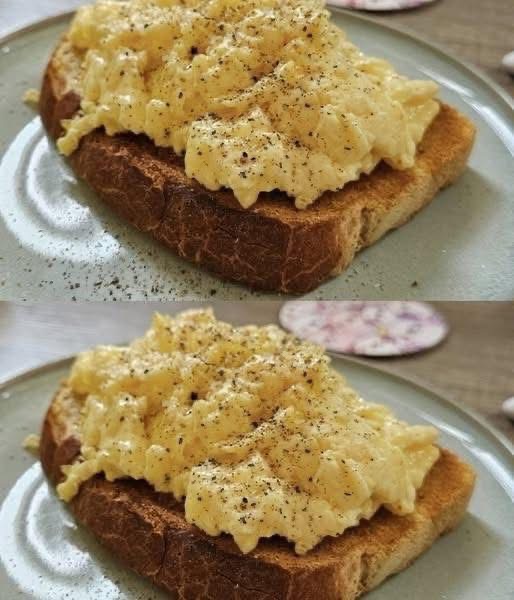Of course! Making perfect scrambled eggs seems simple, but the difference between good and great is all in the technique. The goal is eggs that are creamy, soft, moist, and full of flavor, not dry or rubbery.
Here is the foolproof method for the best scrambled eggs you’ve ever had.
The Perfect Scrambled Eggs: A Step-by-Step Guide
This method focuses on low, gentle heat and constant attention.
Ingredients for 2 Servings:
· 4 large eggs
· 1 tablespoon whole milk, half-and-half, or heavy cream (optional, but adds richness)
· 1 tablespoon unsalted butter
· Salt and freshly ground black pepper
· Optional add-ins: Fresh chives, shredded cheese, a pinch of paprika
Equipment:
· A non-stick skillet is highly recommended.
· A rubber spatula or wooden spoon.
The Technique (The Most Important Part):
- Prep the Eggs:
· Crack the eggs into a medium bowl. Add the milk or cream (if using) and a pinch of salt. Do not add pepper yet, as it can sometimes give a grayish color to the eggs during cooking.
· Whisk vigorously until the yolks and whites are completely combined and the mixture is uniform in color. You should see a slight froth on the surface. This incorporates air and is key for fluffiness.
- Preheat the Pan:
· Place your non-stick skillet over medium-low heat. Let it get warm, but not screaming hot. This is the secret: low and slow.
· Add the butter. Once it melts and starts to foam slightly (but before it browns!), it’s ready.
- Cook Low and Slow:
· Pour the egg mixture into the pan. Let it sit for about 10-15 seconds until a thin layer of cooked egg starts to set on the bottom.
· Now, start stirring. Using your spatula, push the cooked eggs from the edges toward the center. Tilt the pan to let the uncooked, runny egg fill the empty spaces.
· Continue this process: push, fold, tilt. You are not scrambling aggressively; you are gently folding the eggs onto themselves. This creates large, soft, creamy curds.
- Know When to Stop:
· The entire process should take 3-5 minutes. Remove the pan from the heat just before they look completely done to you. The eggs will continue to cook from the residual heat in the pan (carryover cooking).
· They are perfect when they are soft, glossy, and slightly runny (“baveuse” as the French say). If they look dry in the pan, they will be dry on the plate.
- Final Seasoning and Serve:
· Immediately transfer the eggs to a warm plate. They will finish setting on the way to the table.
· Season with freshly ground black pepper and any other herbs (like chives) or cheese. If you didn’t salt the raw eggs, season with salt now.
· Serve immediately! Perfect scrambled eggs wait for no one.
Key Principles for Perfection:
· Low Heat is Non-Negotiable: High heat makes eggs tough, rubbery, and watery (as the proteins squeeze out moisture). Gentle heat allows for creamy, tender curds.
· Constant, Gentle Motion: This isn’t a “set it and forget it” process. Your constant attention ensures even cooking and the perfect curd size.
· Undercook Slightly: The most common mistake is overcooking. Take them off the heat when they are still a bit wet.
· Salt Early (or Late): Salting the raw eggs can help them retain moisture and season them throughout. Some argue it can thin the eggs slightly. Both methods work; salting early is more foolproof for most home cooks.
Troubleshooting & Pro Tips:
· My eggs are dry and rubbery: The heat was too high and/or they were cooked for too long.
· My eggs are watery: The heat was too high, causing the proteins to tighten and squeeze out liquid. This is called syneresis.
· My eggs are flat, not fluffy: The heat was too high, cooking them too fast to form curds. Whisking more vigorously to incorporate air will also help.
· For Ultra-Creamy (French-Style) Eggs: For the most decadent, custard-like eggs, you can use a double boiler (a bowl set over a pot of simmering water). This is the slowest, most controlled method of all.
· Adding Cheese: Stir in shredded cheese right at the end, just after you’ve taken the pan off the heat. The residual heat will melt it perfectly.
Visual Cues:
· Perfect: Large, soft, yellow curds. They look moist and glistening.
· Overcooked: Small, hard, pale yellow or grayish curds. They look dry and may be leaking water.
Master this technique, and you’ll never have subpar scrambled eggs again. Enjoy your perfect breakfast!

